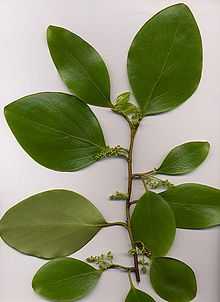Griselinia
| Griselinia | |
|---|---|
 | |
| Griselinia littoralis foliage and flowers | |
| Scientific classification | |
| Kingdom: | Plantae |
| (unranked): | Angiosperms |
| (unranked): | Eudicots |
| (unranked): | Asterids |
| Order: | Apiales |
| Family: | Griseliniaceae J.R.Forst. & G.Forst. ex A.Cunn.[1] |
| Genus: | Griselinia G.Forst. |
| Species | |
|
Griselinia carlomunozii | |
Griselinia is a genus of seven species of shrubs and trees, with a highly disjunct distribution native to New Zealand and South America. It is a classic example of the Antarctic flora. It is the sole genus in the family Griseliniaceae; in the past it was often placed in Cornaceae but differs from that in many features. The leaves are evergreen, smooth and glossy above, often paler below. The flowers are very small, with five sepals and stamens and a single stigma. Petals 2–3 mm long. However, the female flower of G.lucida has no petals. The fruit is a small purple oval berry 5–10 mm long.
Chemical characteristics
Petroselinic acid occurs as the major fatty acid in the species, indicating a relationship to the Apiaceae and the Araliaceae.[2] Recent genetic evidence from the Angiosperm Phylogeny Group has shown that Griselinia is correctly placed in the Apiales.[3]
New Zealand species
The two New Zealand species are large shrubs or trees, from 4–20 m (13–66 ft) tall. Both trees can be epiphytic or hemiepiphytic. The young tree often colonizes amongst other epiphytes like Collospermum and Astelia high in the forest canopy, before growing aerial roots down the trunk of its host. Upon contact with the ground the roots can become large – up to 25 cm (10 in) thick, and are easily identified for their heavy lengthwise corrugations. G. lucida seldom becomes a freestanding tree if having begun life epiphytically, and can often be seen to have collapsed where the host has died. Epiphytic growth in G. littoralis is less common but does occur in wetter climates.
The vernacular names are of Māori origin.
- G. littoralis – Kapuka; leaves 6 cm (2 in) long.
- G. lucida – Puka, akapuka, shining broadleaf; differs from G. littoralis in larger leaves, to 12 cm (5 in) long.
South American species
The five South American species are smaller shrubs, 1–5 m tall. All are known as Yelmo.
- G. carlomunozii – coastal northern Chile (Antofagasta)
- G. jodinifolia – Chile
- G. racemosa – southern Chile (Los Lagos, Aisén) and adjacent Argentina (western Chubut)
- G. ruscifolia – Argentina, Chile, southeast Brazil
- G. scandens – central and southern Chile
References
- ↑ Angiosperm Phylogeny Group (2009). "An update of the Angiosperm Phylogeny Group classification for the orders and families of flowering plants: APG III" (PDF). Botanical Journal of the Linnean Society 161 (2): 105–121. doi:10.1111/j.1095-8339.2009.00996.x. Retrieved 2013-07-06.
- ↑ B. Breuer, T. Stuhlfauth, H. Fock and H. Huber (1987). "Fatty acids of some cornaceae, hydrangeaceae, aquifoliaceae, hamamelidaceae and styracaceae". Phytochemistry 26 (5): 1441–1445. doi:10.1016/S0031-9422(00)81830-0.
- ↑ Maas, P.J.M. & Maas-van de Kamer, H. (2012). Neotropical Griseliniaceae. In: Milliken, W., Klitgård, B. & Baracat, A. (2009 onwards), Neotropikey - Interactive key and information resources for flowering plants of the Neotropics.
External links
- Pictures of Griselinia jodinifolia and Griselinia racemosa from Chilebosque.
| Wikispecies has information related to: Griselinia |
| Wikimedia Commons has media related to Griselinia racemosa. |